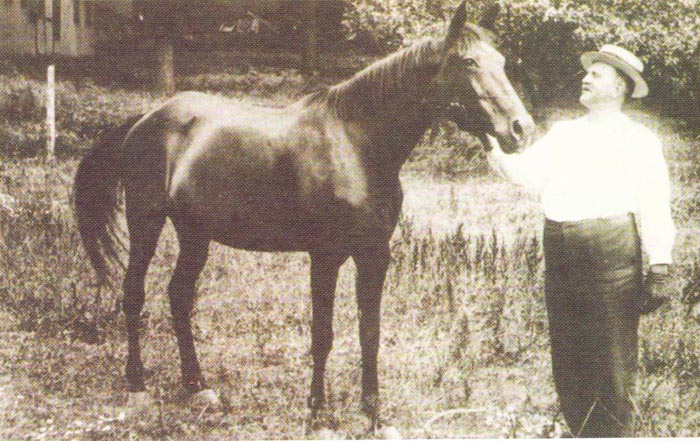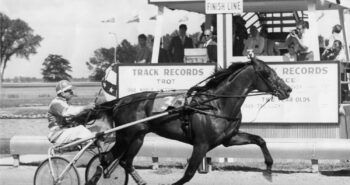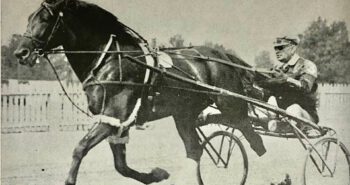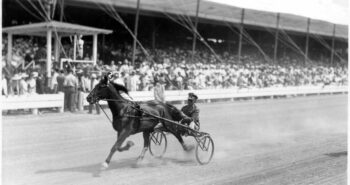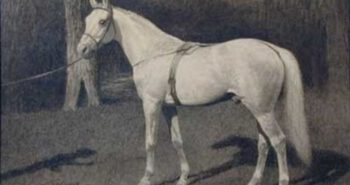She had a questionable pedigree, was difficult to handle, didn’t trot well and didn’t even start a single race. However suspect and hopeless the mare and her background appeared, Santos produced two of the best horses of her day and was a remarkable broodmare.
Peter V Johnston, who trained Santos’ son Peter the Great, also knew the mare really well. “In the winter and spring of 1890-91 Johnston used her for a driving horse and found her ‘bad tempered, bad gaited and with no speed’.” Indeed, Santos never made it to any races, but despite her many shortcomings got her revenge as a broodmare.
Santos’ first foal was the 2:18 (1.25,8) mare Episode, born 1892, by Ambassador. She won a few times for Johnston and in 1898 she was bred to her three-year-old brother Peter the Great. This resulted in the very first foal of the great stallion, a highly inbred filly called Miss Victoria who never made it to the races.
“I don’t like to disgrace her”
Best known, of course, as the dam of Peter the Great, Santos had nine foals. Seven were trotters. All started and all were winners. The other two were pacers, and for breeder DD Streeter that meant there would be no race career. In the old days, pacers were seen as second-, or even third-rate, to trotters. In fact, a mare throwing several pacers would generally reflect negatively on the her abilities as a broodmare. Peter Johnston, the trainer of Peter the Great and most of Santos’ foals, told the story of how Anvil Chorus remained unstarted. As told in the Chicago Tribune Jan 16, 1910:
“Anvil Chorus, full sister to Chimes of Normandy 2:16 1/4 (1.24,7), was the 1901 foal of Santos. She was broken the fall after she was a year old, and the next spring I trained her about sixty days. She was a pacer, and a fast one, showing an eight in :16 and a quarter in :33 that spring. Mr Streeter was then in the west and on his return I told him I thought we had a great pacer. So we hitched her, went to the track, jogged three miles, turned and then I let her step the last quarter of a slow mile in :33 (1.22,0).
‘Yes, she is fast’, said Mr Streeter, ‘but do you think we ought to train any pacers out of Santos? I don’t like to disgrace her?’ ‘If that’s the way you feel, her training will stop right now” I said.
So Anvil Chorus was turned out and in 1904 bred to Direct Hal 2:04 1/4 (1.17,4) pacing, the produce being the black colt Thespian, to which I gave a 2-year-old record of 2:18 1/4 (1.25,9).”
Thespian later lowered his record in a time trial to p2:07 1/4 (1.19,1).
A huge talent
Santos’ last foal was J Malcolm Forbes, by Bingen. The colt was nothing special at 2, a record of 2:30 not intimidating anybody. That fall his breeder and owner DD Streeter died, and J Malcolm Forbes was auctioned off for $3,750 to James R Magowan. However, a winter of training did wonders and the colt was at times sensational at three in 1910, winning in 2:09 1/4 (1.20,3) at the Blue Grass Fair in Lexington. He also trotted in 2:14 1/4 (1.23,4) at Montgomery County Fair, a record for a three-year-old on half-mile track. Unfortunately he didn’t get a chance to prove himself in the Kentucky Futurity. One of two pre-race favorites, Colorado E was the other, J Malcolm Forbes was sick and scratched from the $21,000 Kentucky Futurity – coincidentally won by Grace, also known as Grace Shaw, a daughter of Peter the Great.
At four, he reduced his record to a credible 2:08 (1.19,6), but most people felt he could have gone a lot faster. In fact, during that season there had been speculation that J Malcolm Forbes could beat The Harvester’s stallion record of 2:02 (1.15,8). However, as it turned out the colt didn’t come close. At five, J Malcolm Forbes already made a name for himself as a sire with one two-year-old, Victor Forbes, and five yearlings on the 2:30 list. After seemingly being in retirement for two years, Magowan decided to send J Malcolm Forbes to famed trainer “Pop” Geers in October 1914. However, the colt broke down a few days before his first race for the legendary trainer.
| Year | Name | Sire | Career | Other info |
|---|---|---|---|---|
| 1891 | Episode (f) | Ambassador | 2:18 (1.25,8) | |
| 1895 | Peter the Great (c) | Pilot Medium | 4,2:07 1/4 (1.19,1) | Winner of the 1898 Kentucky Futurity |
| 1897 | Barzaleel (g) | Spottswood | 2:20 1/4 (1.27,2) | |
| 1900 | Chimes of Normandy (f) | Chimes | 2:16 1/4 (1.24,7) | |
| 1901 | Anvil Chorus (f) | Chimes | ||
| 1903 | Nautilus (f) | Chimes | ||
| 1905 | Music Master (c) | Don Wilkes | 2:29 3/4 (1.33,1) | |
| 1906 | Shultsworthy (c) | Maxworthy | 2:26 1/2 (1.31,0) | Exported to Russia |
| 1907 | J Malcolm Forbes (c) | Bingen | 2:08 (1.19,6) |
Interestingly, Santos could seemingly make a winner out of any stallion. Note, however, that both Peter the Great and J Malcolm Forbes needed lots of weight to trot and Johnston was unequivocal that the latter was naturally double-gaited. This was a common thing for the Santos’ foals, they needed weight and time to trot, but they all had ability.
The search for a pedigree
Santos’ pedigree was for long a big source of contention, and this only grew when her son Peter the Great was sold for a massive $50,000. Harness historians couldn’t make heads or tails of the maternal side, but knew something was amiss with Santos’ pedigree and started digging. The primary problem was with Santos’ dam Shadow. Santos’ breeder Samuel A Browne, Shadow had registered Shadow as being by Octoroon, dam Swallow by Joe Hooker, second dam by Sam Johnson, and stated that she [Shadow] was bred by Jonathan Hardin, Nashville, Tenn. A key problem with this is that nobody was ever able to locate a “Jonathan Hardin” in Nashville, or indeed anybody who even knew such a person.
In 1922 they settled on her currently accepted, official, pedigree. After some digging, people concluded that Shadow was the same mare as Lady Duncan, a speedy mare in Nashville who had been bought by Samuel A Browne. Lady Duncan was bred by the wife of Dr Greenfield of Clarksville, TN, and her dam, Dixie, was bred by her father Nicholas Barker. Browne had taken his new mare to Michigan and started a few races in 1875, though without much luck. He had also changed her name to Shadow and bred her to Grand Sentinel, which got Santos. As a yearling, Santos was sold at auction for $850 to JI Case of Janesville, WI. It’s not known why, but a year later he put her up for sale at auction where she fetched $470, being bought by Case’s brother-in-law HD McKinney. Oddly enough, McKinney soon thereafter sold Santos back to Browne. The breeder didn’t seem to interested in hanging on to the difficult mare, and sold her to fellow Kalamazoan Streeter.
The known pedigree of Lady Duncan differed somewhat from the pedigree Browne had registered to Shadow, but with out of the way, the rumor about the shady pedigree disappeared. Where the name “Jonathan Hardin” came from, though, nobody knew. Samuel A Browne died in 1895, and could not be asked to explain the origin of the name. It didn’t matter though, as persistence of the pedigree detectives won through – just as it did for the owner Daniel Streeter and the foals of Santos. The mare who couldn’t trot delivered seven winners, all from different sires. Her maternal family is still alive in Germany and the Netherlands, but hasn’t produced many top trotters. One notable exception, though, is Velten von Flevo, winner of the 2019 German Derby, whose maternal line goes straight back to Anvil Chorus.
Daniel D Streeter died in 1909. His wife sold all of his horse stock except for Santos, who lived out her life at the Streeter farm. Santos died in April 1916, aged 29, due to “infirmities of old age.” She had been blind for a number of years and had not produced a foal for nine years but remained in apparently good health until shortly before her death.
Santos
Brown filly born in Kalamazoo, MI on Apr 24, 1887. Died in Kalamazoo, MI on Apr 15, 1916.
Grand Sentinel – Shadow (Octoroon Jr)
unstarted
Breeder: Samuel A Browne
Owners: Samuel A Browne – J.I. Case – H.D. McKinney – Daniel D. Streeter
Trainer: –
Driver: –
Groom: –

